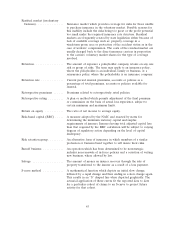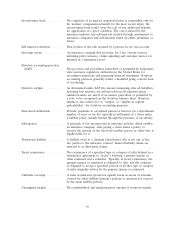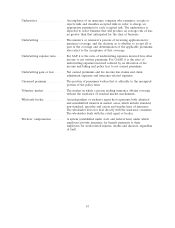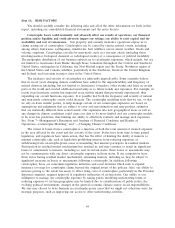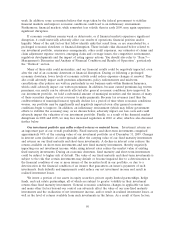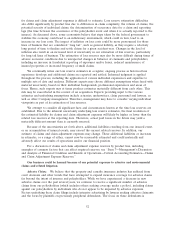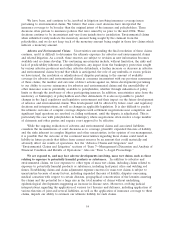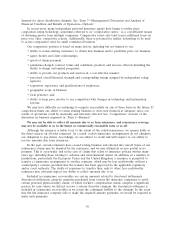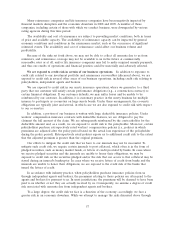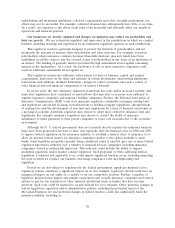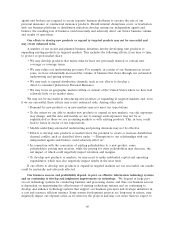Travelers 2009 Annual Report Download - page 64
Download and view the complete annual report
Please find page 64 of the 2009 Travelers annual report below. You can navigate through the pages in the report by either clicking on the pages listed below, or by using the keyword search tool below to find specific information within the annual report.for claims and claim adjustment expenses is difficult to estimate. Loss reserve estimation difficulties
also differ significantly by product line due to differences in claim complexity, the volume of claims, the
potential severity of individual claims, the determination of occurrence date for a claim and reporting
lags (the time between the occurrence of the policyholder event and when it is actually reported to the
insurer). As discussed above, some economists believe that steps taken by the federal government to
stabilize the economy could lead to an inflationary environment, which could in turn, lead to an
increase in our loss costs. The impact of inflation on loss costs could be more pronounced for those
lines of business that are considered ‘‘long tail’’, such as general liability, as they require a relatively
long period of time to finalize and settle claims for a given accident year. Changes in the level of
inflation also result in an increased level of uncertainty in our estimation of loss reserves, particularly
for long tail lines of business. The estimation of loss reserves may also be more difficult during times of
adverse economic conditions due to unexpected changes in behavior of claimants and policyholders,
including an increase in fraudulent reporting of exposures and/or losses, reduced maintenance of
insured properties or increased frequency of small claims.
We continually refine our loss reserve estimates in a regular, ongoing process as historical loss
experience develops and additional claims are reported and settled. Informed judgment is applied
throughout the process, including the application of various individual experiences and expertise to
multiple sets of data and analyses. Different experts may choose different assumptions when faced with
material uncertainty, based on their individual backgrounds, professional experiences and areas of
focus. Hence, such experts may at times produce estimates materially different from each other. This
risk may be exacerbated in the context of an acquisition. Experts providing input to the various
estimates and underlying assumptions include actuaries, underwriters, claim personnel and lawyers, as
well as other Company management. Therefore, management may have to consider varying individual
viewpoints as part of its estimation of loss reserves.
We attempt to consider all significant facts and circumstances known at the time loss reserves are
established. Due to the inherent uncertainty underlying loss reserve estimates, the final resolution of
the estimated liability for claims and claim adjustment expenses will likely be higher or lower than the
related loss reserves at the reporting date. Therefore, actual paid losses in the future may yield a
materially different amount than is currently reserved.
Because of the uncertainties set forth above, additional liabilities resulting from one insured event,
or an accumulation of insured events, may exceed the current related reserves. In addition, our
estimate of claims and claim adjustment expenses may change. These additional liabilities or increases
in estimates, or a range of either, cannot now be reasonably estimated and could materially and
adversely affect our results of operations and/or our financial position.
For a discussion of claims and claim adjustment expense reserves by product line, including
examples of common factors that can affect required reserves, see ‘‘Item 7—Management’s Discussion
and Analysis of Financial Condition and Results of Operations—Critical Accounting Estimates—Claims
and Claim Adjustment Expense Reserves.’’
Our business could be harmed because of our potential exposure to asbestos and environmental
claims and related litigation.
Asbestos Claims. We believe that the property and casualty insurance industry has suffered from
court decisions and other trends that have attempted to expand insurance coverage for asbestos claims
far beyond the intent of insurers and policyholders. While we have experienced a decrease in new
asbestos claims over the past several years, we continue to receive a significant number of asbestos
claims from our policyholders (which includes others seeking coverage under a policy), including claims
against our policyholders by individuals who do not appear to be impaired by asbestos exposure.
Factors underlying these claim filings include intensive advertising by lawyers seeking asbestos claimants
and the focus by plaintiffs on previously peripheral defendants. The focus on these defendants is
52





